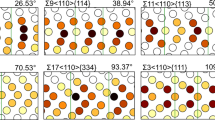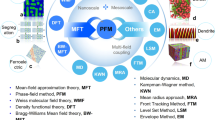Abstract
Phase-field modeling plays a pivotal role in the study of microstructure evolution, offering a crucial tool for understanding and predicting changes in material systems based on thermodynamics. This modeling approach excels in predicting the intricate side-branching patterns characteristic of dendritic growth, without explicit tracking of solid–liquid interfaces. However, the phase-field method often incurs significant computational costs, as it typically involves solving a system of coupled partial differential equations for a set of continuous field variables. Moreover, spatial discretization must be fine enough to resolve microstructure features like grain boundaries or side-branches. Additionally, obtaining an understanding of the effects of material properties often requires a substantial number of simulation results. To address these challenges, recent advances have combined high-throughput phase-field simulations with machine learning techniques, enabling the discovery of analytical expressions for specific material properties based on varying parameters. This approach offers valuable guidance for experimental design, significantly shortening development timelines and reducing costs for new materials. Although high-throughput phase-field simulations combined with machine learning have reduced the number of required databases, they still necessitate enough simulations for database construction. To further expedite this process, acceleration approaches like graphics processing unit (GPU)-based phase-field simulation and the utilization of physics-informed neural networks (PINNs) for phase-field modeling are being explored. With ongoing advancements in computational speed, the integration of machine learning into material development processes is increasingly regarded as an efficient method for further accelerating the pace of material innovation.






Similar content being viewed by others
References
L.Q. Chen, Phase-field models for microstructure evolution. Annu. Rev. Mater. Res. 32(1), 113–140 (2002)
Q. Wang, G. Zhang, Y. Li, Z. Hong, D. Wang, S. Shi, Application of phase-field method in rechargeable batteries. npj Comput. Mater. 6(1), 176 (2020)
I. Steinbach, Phase-field models in materials science. Modell. Simul. Mater. Sci. Eng. 17(7), 073001 (2009)
W.J. Boettinger, J.A. Warren, C. Beckermann, A. Karma, Phase-field simulation of solidification. Annu. Rev. Mater. Res. 32(1), 163–194 (2002)
T.Q. Ansari, H. Huang, S.Q. Shi, Phase field modeling for the morphological and microstructural evolution of metallic materials under environmental attack. npj Comput. Mater. 7(1), 143 (2021)
Provatas, N. and K. Elder, Phase-field methods in materials science and engineering. 2011: John Wiley & Sons.
S. Kovacevic, W. Ali, E. Martínez-Pañeda, Javier LLorca, Phase-field modeling of pitting and mechanically-assisted corrosion of Mg alloys for biomedical applications. Acta Biomater. 164, 641–658 (2023)
L. Gránásy, L. Rátkai, G.I. Tóth, P.U. Gilbert, I. Zlotnikov, T. Pusztai, Phase-field modeling of biomineralization in mollusks and corals: Microstructure vs formation mechanism. JACS Au 1(7), 1014–1033 (2021)
M. Plapp, Phase-field models, in Handbook of Crystal Growth. (Elsevier, 2015), pp.631–668
L. Gránásy, L. Rátkai, A. Szállás, B. Korbuly, G.I. Tóth, L. Környei, T. Pusztai, Phase-field modeling of polycrystalline solidification: from needle crystals to spherulites—a review. Metall. Mater. Trans. A 45, 1694–1719 (2014)
F. Yu, Y. Wei, Y. Ji, L.Q. Chen, Phase field modeling of solidification microstructure evolution during welding. J. Mater. Process. Technol. 255, 285–293 (2018)
R. Spatschek, C. Müller Gugenberger, E. Brener, B. Nestler, Phase field modeling of fracture and stress-induced phase transitions. Phys. Rev. E 75(6), 066111 (2007)
M. Mamivand, M.A. Zaeem, H. El Kadiri, A review on phase field modeling of martensitic phase transformation. Comput. Mater. Sci. 77, 304–311 (2013)
H.K. Kim, S.G. Kim, W. Dong, I. Steinbach, B.J. Lee, Phase-field modeling for 3D grain growth based on a grain boundary energy database. Modell. Simul. Mater. Sci. Eng. 22(3), 034004 (2014)
P. Staublin, A. Mukherjee, J.A. Warren, P.W. Voorhees, Phase-field model for anisotropic grain growth. Acta Mater. 237, 118169 (2022)
J. Kundin, L. Mushongera, T. Goehler, H. Emmerich, Phase-field modeling of the γ′-coarsening behavior in Ni-based superalloys. Acta Mater. 60(9), 3758–3772 (2012)
M. Yang, L. Wang, W. Yan, Phase-field modeling of grain evolutions in additive manufacturing from nucleation, growth, to coarsening. NPJ Comput. Mater. 7(1), 56 (2021)
R. Spatschek, E. Brener, A. Karma, Phase field modeling of crack propagation. Phil. Mag. 91(1), 75–95 (2011)
A. Karma, D.A. Kessler, H. Levine, Phase-field model of mode III dynamic fracture. Phys. Rev. Lett. 87(4), 045501 (2001)
A. Mukherjee, K. Ankit, R. Mukherjee, B. Nestler, Phase-field modeling of grain-boundary grooving under electromigration. J. Electron. Mater. 45, 6233–6246 (2016)
D.N. Bhate, A. Kumar, A.F. Bower, Diffuse interface model for electromigration and stress voiding. J. Appl. Phys. 87(4), 1712–1721 (2000)
T. Takaki, T. Shimokawabe, M. Ohno, A. Yamanaka, T. Aoki, Unexpected selection of growing dendrites by very-large-scale phase-field simulation. J. Cryst. Growth 382, 21–25 (2013). https://doi.org/10.1016/j.jcrysgro.2013.07.028
H.G. Lee, S.Y. Kim, J.S. Lee, Dynamic observation of dendrite growth on lithium metal anode during battery charging/discharging cycles. npj Comput. Mater. 8(1), 103 (2022)
C. Xu, C. Lei, Y. Wang, C. Yu, Dendritic mesoporous nanoparticles: structure, synthesis and properties. Angew. Chem. Int. Ed. 61(12), e202112752 (2022)
N. Sui, K. Wang, X. Shan, Q. Bai, L. Wang, H. Xiao, M. Liu, V.L. Colvin, W.Y. William, Facile synthesis of hollow dendritic Ag/Pt alloy nanoparticles for enhanced methanol oxidation efficiency. Dalton Trans. 46(44), 15541–15548 (2017)
Y. Shin, C. Lee, M.S. Yang, S. Jeong, D. Kim, T. Kang, Two-dimensional hyper-branched gold nanoparticles synthesized on a two-dimensional oil/water interface. Sci. Rep. 4(1), 6119 (2014). https://doi.org/10.1038/srep06119
Z. Chen, Y. Hu, X. He, T. Xiao, L. Hao, Y. Ruan, Phase-field crystal method for multiscale microstructures with cubic term. Mater. Today Commun. 29, 102935 (2021)
K. Qian, A. Pawar, A. Liao, C. Anitescu, V. Webster Wood, A.W. Feinberg, T. Rabczuk, Y.J. Zhang, Modeling neuron growth using isogeometric collocation based phase field method. Sci. Rep. 12(1), 8120 (2022). https://doi.org/10.1038/s41598-022-12073-z
M.A. Zaeem, H. Yin, S.D. Felicelli, Modeling dendritic solidification of Al–3% Cu using cellular automaton and phase-field methods. Appl. Math. Model. 37(5), 3495–3503 (2013). https://doi.org/10.1016/j.apm.2012.08.005
H. Lee, T. Kwak, W. Lee, J. Song, D. Kim, Effect of surface topography on dendritic growth in lithium metal batteries. J. Power. Sources 552, 232264 (2022). https://doi.org/10.1016/j.jpowsour.2022.232264
L. Chen, H.W. Zhang, L.Y. Liang, Z. Liu, Y. Qi, P. Lu, J. Chen, L.Q. Chen, Modulation of dendritic patterns during electrodeposition: a nonlinear phase-field model. J. Power. Sources 300, 376–385 (2015). https://doi.org/10.1016/j.jpowsour.2015.09.055
X. Shen, R. Zhang, P. Shi, X. Chen, Q. Zhang, How does external pressure shape Li dendrites in Li metal batteries? Adv. Energy Mater. 11(10), 2003416 (2021). https://doi.org/10.1002/aenm.202003416
T. Xue, Z. Gan, S. Liao, J. Cao, Physics-embedded graph network for accelerating phase-field simulation of microstructure evolution in additive manufacturing. npj Comput. Mater. 8(1), 201 (2022)
Y. Zhu, T. Xu, Q. Wei, J. Mai, H. Yang, H. Zhang, T. Shimada, T. Kitamura, T.Y. Zhang, Linear-superelastic Ti-Nb nanocomposite alloys with ultralow modulus via high-throughput phase-field design and machine learning. npj Comput. Mater. 7(1), 205 (2021)
Z.H. Shen, J.J. Wang, J.Y. Jiang, S.X. Huang, Y.H. Lin, C.W. Nan, L.Q. Chen, Y. Shen, Phase-field modeling and machine learning of electric-thermal-mechanical breakdown of polymer-based dielectrics. Nat. Commun. 10(1), 1843 (2019). https://doi.org/10.1038/s41467-019-09874-8
W. Li, T. Yang, C. Liu, Y. Huang, C. Chen, H. Pan, G. Xie, H. Tai, Y. Jiang, Y. Wu, Optimizing piezoelectric nanocomposites by high-throughput phase-field simulation and machine learning. Adv. Sci. 9(13), 2105550 (2022)
V.K. Thakur, R.K. Gupta, Recent progress on ferroelectric polymer-based nanocomposites for high energy density capacitors: synthesis, dielectric properties, and future aspects. Chem. Rev. 116(7), 4260–4317 (2016)
Z. Pan, B. Liu, J. Zhai, L. Yao, K. Yang, B. Shen, NaNbO3 two-dimensional platelets induced highly energy storage density in trilayered architecture composites. Nano Energy 40, 587–595 (2017)
K. Zhang, J. Wang, Y. Huang, L.Q. Chen, P. Ganesh, Y. Cao, High-throughput phase-field simulations and machine learning of resistive switching in resistive random-access memory. Npj Comput. Mater. 6(1), 198 (2020)
C. Kim, G. Pilania, R. Ramprasad, From organized high-throughput data to phenomenological theory using machine learning: the example of dielectric breakdown. Chem. Mater. 28(5), 1304–1311 (2016)
K.T. Butler, D.W. Davies, H. Cartwright, O. Isayev, A. Walsh, Machine learning for molecular and materials science. Nature 559(7715), 547–555 (2018)
Y. Xu, Q. Qian, i-SISSO: Mutual information-based improved sure independent screening and sparsifying operator algorithm. Eng. Appl. Artif. Intell. 116, 105442 (2022)
Y. Ren, K. Zhang, Y. Zhou, Y. Cao, Phase-field simulation and machine learning study of the effects of elastic and plastic properties of electrodes and solid polymer electrolytes on the suppression of Li dendrite growth. ACS Appl. Mater. Interfaces 14(27), 30658–30671 (2022). https://doi.org/10.1021/acsami.2c03000
Z. Mu, Z. Guo, Y.H. Lin, Simulation of 3-D lithium dendritic evolution under multiple electrochemical states: A parallel phase field approach. Energy Storage Materials 30, 52–58 (2020). https://doi.org/10.1016/j.ensm.2020.04.011
Ajayakumar, G., J. Fojt, J. Tan, and L. Nielsen, Solving the Poisson equation with GPU acceleration. 2023
S. Sakane, T. Takaki, M. Ohno, T. Shimokawabe, T. Aoki, GPU-accelerated 3D phase-field simulations of dendrite competitive growth during directional solidification of binary alloy. IOP Conf. Ser. Mater Sci Eng. (2015). https://doi.org/10.1088/1757-899X/84/1/012063
G. Karniadakis, I. Kevrekidis, L. Lu, P. Perdikaris, S. Wang, L. Yang, Physics-informed machine learning. Nat. Rev. Phys. (2021). https://doi.org/10.1038/s42254-021-00314-5
R. Mattey, S. Ghosh, A novel sequential method to train physics informed neural networks for allen cahn and cahn hilliard equations. Comput. Methods Appl. Mech. Eng. 390, 114474 (2022). https://doi.org/10.1016/j.cma.2021.114474
R. Qiu, R. Huang, Y. Xiao, J. Wang, Z. Zhang, J. Yue, Z. Zeng, Y. Wang, Physics-informed neural networks for phase-field method in two-phase flow. Phys. Fluids (2022). https://doi.org/10.1063/5.0091063
Wight, C.L. and J. Zhao, Solving Allen-Cahn and Cahn-Hilliard equations using the adaptive physics informed neural networks. arXiv preprint arXiv:2007.04542, 2020. https://doi.org/10.48550/arXiv.2007.04542
Acknowledgements
This work was supported by the Korea Institute for Advancement of Technology funded By the Ministry of Trade, Industry& Energy (MOTIE, Korea) (No.P0018649, Fuel Cell Element Part and System Technology Development for Fuel Cell Powered Tram). This work was also supported by the National Research Foundation of Korea (NRF) grant funded by the Korea government (MSIT) (No.2020R1A2C2010986, 2022M3H4A1A04085301).
Author information
Authors and Affiliations
Corresponding author
Ethics declarations
Conflict of Interest
All authors certify that they have no affiliations with or involvement in any organization or entity with any financial interest or non-financial interest in the subject matter or materials discussed in this manuscript.
Additional information
Publisher's Note
Springer Nature remains neutral with regard to jurisdictional claims in published maps and institutional affiliations.
Rights and permissions
Springer Nature or its licensor (e.g. a society or other partner) holds exclusive rights to this article under a publishing agreement with the author(s) or other rightsholder(s); author self-archiving of the accepted manuscript version of this article is solely governed by the terms of such publishing agreement and applicable law.
About this article
Cite this article
Lee, H., Kim, D. Recent Computational Approaches for Accelerating Dendrite Growth Prediction: A Short Review. Multiscale Sci. Eng. 5, 119–125 (2023). https://doi.org/10.1007/s42493-024-00098-7
Received:
Revised:
Accepted:
Published:
Issue Date:
DOI: https://doi.org/10.1007/s42493-024-00098-7




